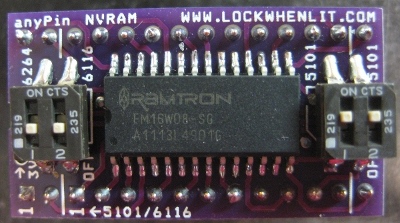


 |
 |
 |
| Front | Back | Side |
LockWhenLit has released an interesting solution for games that use either 5101 or 6116 battery backed CMOS RAM to store game audits, settings, and high score information. It uses a RAMTRON chip, which eliminates the battery entirely, protecting the board from future damage due to battery leakage. By replacing obsolete parts with new ones, this design should help keep our games running in to the future.
Physically, this little board is somewhat larger than the 5101 that it replaces. On the top side of the board, the RAMTRON chip and a set of DIP switches reside. The DIP switches allow configuring the board as a 5101 replacement, or as a 6116 replacement. This could be especially handy for people that do a lot of game repairs, as it eliminates having to stock and maintain multiple parts. Just set the switches appropriately, pop the board in in place of the original chip, and you're done.
The bottom side of the board is interesting, in that it has multiple sets of header pins mounted, to account for the different pin spacings of the original 5101 and 6116 parts. Some additional logic chips are hiding down here out of the way as well. The board includes a set of .100" socket pins installed by default, setting the board up for a 5101 install. To change it to a 6116, remove the socket pins, change the DIP switches, and it's ready to go.
Zaccaria used 5101 RAM and a NiCad battery to store game settings and audits on their 1st generation games (1B1110, 1B1110/0, 1B1110/1, and 1B1110/1a CPU boards). Many of the original batteries were never replaced, because they were soldered to the board, and have long since leaked their fluid, causing damage ranging from minor to extensive. Sadly, LockWhenLit's board was not available 20+ years ago to prevent this from happening.
LockWhenLit was kind enough to send me a sample of this board for evaluation and testing. I configured it for a 5101 replacement, installed it at IC7 on a 1B1110/1 CPU board that I use for development and testing, and ran the board on my test bench.
The LockWhenLit board is a bigger in all dimensions than a 5101, but its design raises it above the board sufficiently that it does not have any interferance problems with surrounding chips or parts.
I first ran my test ROM in the board, using its memory tests to confirm that the replacement works correctly. No problems where found here, and it passed all of my normal tests with flying colours.
I then installed a set of game ROMs (Star God) in the board, and used those to confirm that the replacement RAM would allow clearing the operator audits, changing the game settings, and that the board passed all of the game's normal self tests. Again, no problems found.
Since I was running these tests on my test bench only, not in a game, I can only perform limited "game play" testing, but no problems were found there either.
In summary, LockWhenLit has produced a really nice and flexible solution to solve several problems all at once. This board replaces obsolete parts, which while still available, are starting to become more difficult to obtain (and more expensive, as the supply dries up). It removes a major source of future failure (NiCad batteries). And, especially if you repair or maintain many different games, it eliminates having to have 5101 and 6116 RAM chips on hand.
| Web Site: | http://www.lockwhenlit.com/ |
| Email: | LockWhenLit@gmail.com |
David Gersic
Copyright © 2013. All rights reserved.
This document may be freely distributed so long as the content is not modified.